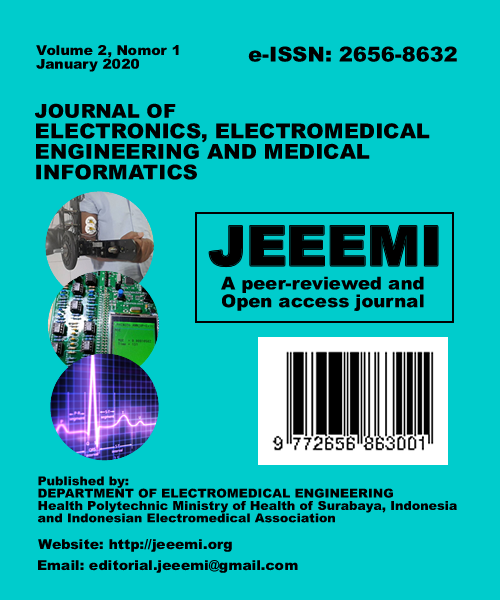Effect of Temperature on pH Meter Based on Arduino Uno With Internal Calibration
Abstract
pH Meter is a device used to express the level of acidity or basicity possessed by a substance or solution. Normal pH has a value of 7 while the pH value> 7 indicates that the substance has alkaline properties while the pH value <7 indicates acidic properties. pH 0 shows a high degree of acidity, and pH 14 shows the highest degree of alkalinity. pH Meter reads the pH and temperature values in a sample. The author uses glass electrodes as a pH sensor, DS18B20 as a temperature sensor and LCD to make pH and temperature values. This module is equipped with an internal calibration that is used to set the module to read the pH value properly and correctly using a pH buffer and equipped with internal storage and this module facilitates battery usage. Based on pH measurements on the module the error value in buffer 4 calibration is 5.39%, in buffer 7 is 1.76%, in buffer 10 is 1.04%. The highest error value in the measurement sample is 3.54% and the lowest error value is 0.03%. The temperature of the sample is very influential on the reading of the pH value because the higher the temperature the pH value also increases even though it is not so significant.
Downloads
Authors who publish with this journal agree to the following terms:
- Authors retain copyright and grant the journal right of first publication with the work simultaneously licensed under a Creative Commons Attribution-ShareAlikel 4.0 International (CC BY-SA 4.0) that allows others to share the work with an acknowledgement of the work's authorship and initial publication in this journal.
- Authors are able to enter into separate, additional contractual arrangements for the non-exclusive distribution of the journal's published version of the work (e.g., post it to an institutional repository or publish it in a book), with an acknowledgement of its initial publication in this journal.
- Authors are permitted and encouraged to post their work online (e.g., in institutional repositories or on their website) prior to and during the submission process, as it can lead to productive exchanges, as well as earlier and greater citation of published work (See The Effect of Open Access).





.png)
.png)
.png)
.png)
.png)
